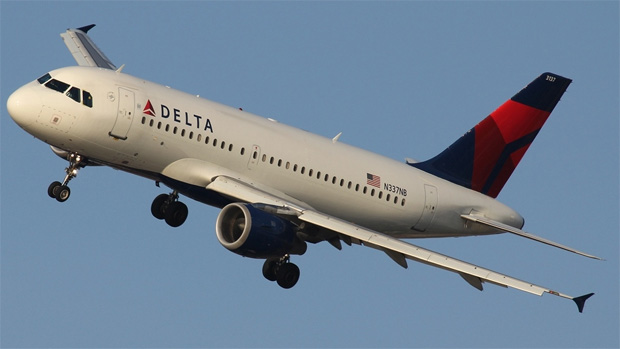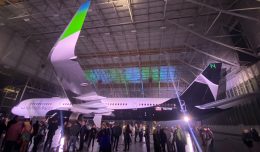It is a good day for hub busting. The schedule for Delta Air Line’s new LaGaurdia hub includes new nonstops to every major hub within the airport’s 1,500-mile perimeter – Charlotte, Dallas/Ft. Worth, Denver, Houston Intercontinental, Miami, Philadelphia and Washington Dulles all will receive nonstop flights in 2012. Beware American Airlines, United Airlines and US Airways.

A Delta Air Lines Airbus A319 banking steeply on LaGuardia Airport's Expressway Visual approach. (Photo by Kaz T)
“Our new LaGuardia schedule puts Delta in nearly all of the top 50 markets from LaGuardia,” said Gail Grimmett, Delta’s senior vice president New York, in a statement. Dan Webbage points out that Delta will serve 37 of the top 50 destinations by daily originating passengers from LaGuardia with its new schedule in a recent blog post.
Delta’s new LaGuardia operation was made possible by a slot swap agreement with US Airways. The Atlanta-based carrier traded 50 slot pairs at Washington National (42 went to US Airways and eight were auctioned to JetBlue Airways) in return for 132 slot pairs at LaGuardia (an additional 16 pairs were auctioned to JetBlue and WestJet Airlines) that closed on December 13. The agreement ended nearly two decades of the Phoenix-based airline being the largest airline at LaGuardia by number of slots.
Small cities are missing from Delta’s new schedule. Many of the small communities in the northeast and mid-Atlantic that historically had service to LaGuardia now will not. Gone are flights to Baltimore, Hartford, Harrisburg, Ithaca and Providence – all destinations currently served by US Airways – according to Delta’s December schedule and list of new flights. Yes, some of these routes are short enough to make driving or the train a convenient alternative and others may receive flights come warmer months, but it stands that Delta’s new schedule includes few small destinations and no new cities for the airport. Instead of new flights to, for example, Binghamton or Nantucket, slots are being used to compete with American to Dallas and Miami or United to Denver and Houston.
The business-destination heavy schedule could be a smart choice. The slot swap is expected to generate additional corporate revenue gains in New York, wrote William Greene, an analyst at Morgan Stanley who covers Delta, in a recent report. Routes between New York and medium to large cities will undoubtedly attract more business travellers than those to small ones but, at least on those where it will be going head-to-heard with an established competitor, the new competition could drive down fares and reduce margins for both carriers.
Business destinations alone will not give it a significant advantage over United-Continental’s hub at Newark Liberty International Airport. Delta will have more flights and seats than its Chicago-based competitor, but the latter offers nonstops to a greater diversity of cities – including critical business centers, international capitals and small communities throughout the northeast and mid-Atlantic – from one airport. Arguments can be made either way for how to allocate scarce resources – takeoff and landing slots in this case – but United-Continental’s hub meets the needs of a greater number of travellers, including demanding business customers, while also providing critical air service to smaller communities.
Delta’s preference for larger markets does not come as a surprise. The airline announced plans to either cut or reduce service to 24 small cities, most of which were served under the federal essential air service (EAS) subsidy program, in July. Destinations include Muscle Shoals, Alabama, Sault Ste Marie, Michigan, and Sioux City, Iowa. This has been the trend among US airlines for some time.
At least 27 small airports have lost air service from a major airline service since 2009, according to the Airports Council International. The airport industry body attributes the cuts to high fuel costs and the retirement of small turboprops and regional jets.
Delta is not alone in its hub busting strategy. Spirit Airlines announced new nonstops from Dallas/Ft. Worth to Atlanta, Boston, LaGuardia, Phoenix-Mesa and Orlando following American’s chapter 11 bankruptcy filing last month. It even offered introductory $11 one-way fares on the routes in a cheeky announcement. JetBlue entered the fray shortly thereafter with three new nonstops from Boston to Dallas/Ft. Worth and Virgin America is expected to announce a San Francisco-Philadelphia nonstop early in the new year.
US Airways new schedule at National has yet to be announced. It could follow in Delta’s footsteps and add new nonstops to cities like Atlanta, Cleveland and Minneapolis/St. Paul or, in addition to new flights to key business markets, connect some of the gaps in its current network from the airport, for example to Wilmington, Lexington or Ithaca.
“Many communities, including several smaller ones,” will receive new nonstop flights to National according to a US Airways statement on the slot swap in May.
Delta still has an opportunity at JFK. It previously flew to 16 of the markets, including Albany and Richmond, out of the airport that it will now serve from LaGuardia. It could use some of these now available slots to fly to smaller communities that lack service to New York. This is possible even as Delta maintains a select number of flights to destinations served from LaGuardia in order to provide international connections at JFK.
Caribbean destinations appear to be Delta’s focus from JFK. With the announcement of its new LaGuardia schedule it announced an unspecified number of new flights to the Caribbean, especially to the Dominican Republic and Puerto Rico, from the latter airport – a region well served by American and JetBlue from JFK.
The reality of the slot swap, and US airline consolidation in general, is that major airline services are becoming more homogenous from the largest markets. There is an increasing amount of service duplication in today’s schedules instead of the focus on serving a particular region well from a given airport as airlines did in the past. In New York, Los Angeles and elsewhere carriers are increasingly adding flights to just the largest origination and destination markets and bypassing the small cities that once upon a time sported nonstops to these airports. The only place specialisation still occurs is in markets where air service is the only transport option, for example Alaska Airlines in Alaska and Hawaiian Airlines in Hawaii.
Route specialization in the US is unlikely to ever return but still warrants some amount of nostalgia. This is especially true as the EAS program faces increasing scrutiny in a budget cuts-focused Washington. Of course there is a name for the day when airlines specialized on regions and more airports had air service to big cities. It is called regulation.
Edward Russell is a financial journalist and airline enthusiast based in New York. The son of a pilot, he’s been spotting and collecting airline memorabilia since a young age and has been writing about airlines in the US and Asia since 2006. Follow him on Twitter @e_russell.






